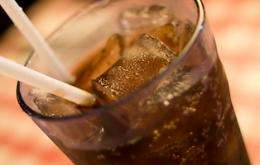 Stop drinking soda every day! Research finds that a daily sugar-sweetened beverage habit may increase the risk for non-alcoholic fatty liver disease (NAFLD). Earlier research has already linked daily sugar-sweetened beverages (typically soda) to type 2 diabetes and cardiovascular disease. And try to avoid high-fructose corn syrup in general (found in many highly processed foods) . From Medical Xpress:
Stop drinking soda every day! Research finds that a daily sugar-sweetened beverage habit may increase the risk for non-alcoholic fatty liver disease (NAFLD). Earlier research has already linked daily sugar-sweetened beverages (typically soda) to type 2 diabetes and cardiovascular disease. And try to avoid high-fructose corn syrup in general (found in many highly processed foods) . From Medical Xpress:
Daily sugar-sweetened beverage habit linked to non-alcoholic fatty liver disease
A daily sugar-sweetened beverage habit may increase the risk for non-alcoholic fatty liver disease (NAFLD), researchers from the Jean Mayer USDA Human Nutrition Research Center on Aging (USDA HRNCA) at Tufts University report today in the Journal of Hepatology.
The researchers analyzed 2,634 self-reported dietary questionnaires from mostly Caucasian middle-aged men and women enrolled in the National Heart Lunch and Blood Institute (NHLBI) Framingham Heart Study's Offspring and Third Generation cohorts....The participants underwent a computed tomography (CT) scan to measure the amount of fat in the liver and the authors of the current study used a previously defined cut-point to identify NAFLD. They saw a higher prevalence of NAFLD among people who reported drinking more than one sugar-sweetened beverage per day compared to people who said they drank no sugar-sweetened beverages.
The relationships between sugar-sweetened beverages and NAFLD persisted after the authors accounted for age, sex, body mass index (BMI), and dietary and lifestyle factors such as calorie intake, alcohol, and smoking. In contrast, after accounting for these factors the authors found no association between diet cola and NAFLD.
NAFLD is characterized by an accumulation of fat in the liver cells that is unrelated to alcohol consumption. NAFLD is diagnosed by ultrasounds, CT, MRI, or biopsy, and many of the approximately 25% of Americans with the disease don't experience any symptoms. Being obese or overweight increases the risk for NAFLD and people with NAFLD are at greater risk of developing cardiovascular disease and type 2 diabetes.Sugar-sweetened beverages are a major dietary source of fructose, the sugar that is suspected of increasing risk of NAFLD because of how our bodies process it.
